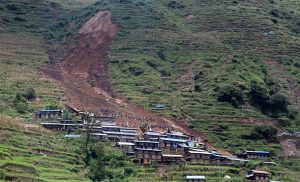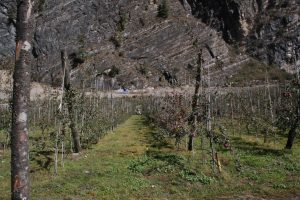
Climate change has emerged as one of the most pressing global challenges of recent times. Nepal, as a developing country, faces several climate-related risks such as glacial melting, irregular rainfall patterns, and natural disasters. To address these challenges, experts are commenting that Nepal needs to focus on climate finance.
The world is slowly shifting its focus on climate finance, and it is time Nepal, which is in a high-risk zone, also focussed its resources on exploring and promoting climate finance. But what is climate finance?
Climate finance refers to the funding allocated for projects and initiatives that mitigate greenhouse gas emissions, enhance climate resilience, and promote sustainable development. Through climate finance, Nepal can mobilise and allocate financial resources to support climate change mitigation and adaptation activities, accelerating its work in the challenges like the melting of glaciers in the Himalayan region, the rising average temperature, and the transition to a low-carbon emission ultimately creating a climate-resilient economy for a sustainable future.
Why is it important?
Climate finance plays a vital role in addressing the challenges posed by climate change for Nepal. Here are a few key aspects to understand the subject matter.
To promote adaptation
Climate finance is crucial for vulnerable communities and countries like Nepal to adapt to the impacts of climate change. It helps protect lives, livelihoods, and ecosystems. Also, it supports initiatives such as the construction of climate-resilient infrastructure, the development of early warning systems, and the implementation of agricultural practices that are resilient to changing climate conditions.
To protect the resources
Nepal is known for its rich biodiversity and unique ecosystems. Climate finance supports initiatives for biodiversity conservation, forest restoration, and the protection of endangered species. These efforts contribute to the preservation of valuable ecosystems, the sustainable use of natural resources, and the maintenance of ecosystem services vital for livelihoods and biodiversity conservation.
To mitigate challenges
It enables the implementation of projects and initiatives aimed at reducing greenhouse gas emissions. It supports the deployment of renewable energy systems, energy efficiency measures, and sustainable transportation solutions. By investing in mitigation efforts, climate finance helps curb the causes of climate change.

To increase capacity
Climate finance enhances the capacity of developing countries like Nepal to design and implement climate change mitigation and adaptation projects. This includes investment in the training of local communities, policymakers, and institutions as well as infrastructures at the grassroots levels and various renewable resources. All the investment will ultimately enable them to effectively respond to climate change challenges with enough investment and sustainable climate actions.
To build climate resilience
Such financing supports Nepal’s efforts to enhance climate resilience. It enables the implementation of adaptation measures, such as building climate-resilient infrastructure, climate-smart practices, studying and collecting data and resources, improving water and land management systems, as well as developing early warning systems to avoid natural disasters. These actions help safeguard vulnerable communities, protect ecosystems, and reduce the impacts of climate-related disasters.
To create jobs and opportunities
Climate finance promotes the development of green jobs and economic opportunities in Nepal. Investments in areas like renewable energy, sustainable tourism, eco-friendly industries, and climate-resilient infrastructure create employment opportunities, foster economic growth, and contribute to poverty alleviation.
To transfer knowledge
Climate finance facilitates the transfer of environment-friendly knowledge and technologies to countries impacted by climate change and its cascading effects by sharing knowledge and expertise on clean energy, sustainable agriculture, adaptation technology, and climate-resilient infrastructure. Enough investment in climate supports developing countries like Nepal in their transition to sustainable development pathways. The investment can all be backed by data for better outcomes.
To promote climate justice
Climate finance recognises the principle of common but differentiated responsibilities, emphasising the historical responsibility of developed countries for climate change. It aims to ensure equity, justice, and global cooperation by providing financial resources to developing countries to tackle climate change, which they are less responsible for but disproportionately affected by.
To increase food security
Climate change impacts are being seen at the lowest of all levels. But with climate finance, investments in climate-smart agriculture practices, sustainable land management, and improved irrigation systems will be possible resulting in agricultural productivity, ensuring food security, and strengthening the resilience of rural communities to climate change impacts.
Challenges and opportunities

The many prospects of climate finance are both promising and challenging. On the positive side, there is a growing global recognition of the urgent need to combat climate change. The Paris Agreement, signed by nearly all nations, has established a goal of mobilising $100 billion per year by 2020 to support climate action in developing countries. This commitment has stimulated increased political will and international cooperation.
The international community, recognising Nepal’s vulnerability to climate change, has expressed a commitment to provide financial support. Various global climate funds, such as the Green Climate Fund (GCF), offer opportunities for Nepal to access climate finance for sustainable development projects.
There is growing awareness among financial institutions and investors of the financial risks associated with climate change. Sustainable and green financial products, such as green bonds and climate-focused investment funds, are gaining traction, indicating a shift towards more climate-conscious investments.
However, challenges remain, including the need for enhanced capacity to access and effectively utilise climate finance resources. Strengthening institutional frameworks, improving financial management systems, and promoting transparency and accountability are essential to maximise the potential of climate finance in Nepal.
Furthermore, there is growing recognition among domestic financial institutions and investors in Nepal about the importance of climate-friendly investments. This presents an opportunity for the private sector to play an active role in climate-related activities, including through the development of green financial products and investments in renewable energy and climate-resilient infrastructure.
























